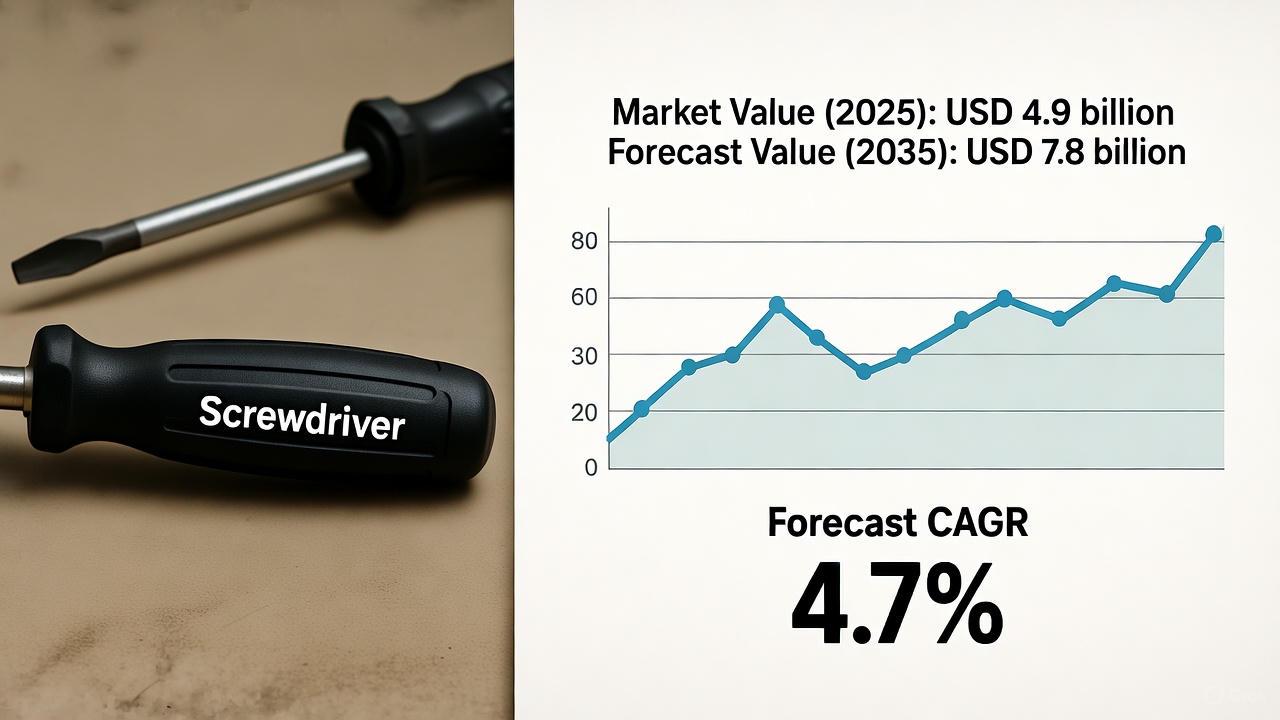Screwdriver Market to Hit USD 7.8 Billion by 2035

The global screwdriver market is projected to reach USD 7.8 billion by 2035, growing from an estimated USD 4.9 billion in 2025 at a compound annual growth rate (CAGR) of 4.7%. This growth reflects the rising demand for both manual and powered tools across consumer and industrial applications, including construction, automotive, electronics, and home improvement projects. The market has demonstrated consistent progress, increasing steadily from USD 3.9 billion in 2021 to USD 4.9 billion in 2025.
As global industries advance, innovations such as cordless, rechargeable, and ergonomically designed screwdrivers are reshaping user expectations. While growth begins to decelerate after 2030 as the market matures, steady demand for tool replacement, specialized features, and durable materials ensures continued expansion.
Full Market Report available for delivery. For purchase or customization, please request here: https://www.futuremarketinsights.com/reports/sample/rep-gb-25725
Why the Market is Growing
The rise in DIY culture and home improvement activities worldwide is contributing significantly to market momentum. Consumers are increasingly investing in toolkits for everyday repairs, furniture assembly, and decorative projects, boosting demand for versatile, affordable screwdrivers. Similarly, professional sectors such as automotive maintenance and construction rely heavily on screwdrivers, further reinforcing their market importance.
Advancements in e-commerce platforms have also expanded product accessibility, particularly in emerging markets. Manufacturers are responding with screwdrivers featuring anti-slip grips, magnetic tips, and durable steel materials that meet the evolving expectations of both professionals and household users.
Segmental Highlights
Manual screwdrivers remain dominant, projected to hold a 47.5% revenue share in 2025, thanks to their simplicity, precision, and affordability. Steel screwdrivers will lead by material, accounting for 52.8% of the market, due to their strength, durability, and resistance to wear. On the application side, DIY and home improvement represent the largest share, expected at 33.9% in 2025, driven by lifestyle shifts toward independent home maintenance.
Cordless screwdrivers and multi-functional models are gaining popularity among professionals and hobbyists alike, supported by advances in battery technology and material strength.
Regional and Country Insights
North America, Asia-Pacific, and Europe remain the key growth regions. China leads with the highest CAGR of 6.3%, driven by its robust manufacturing base, booming automotive sector, and rising DIY culture. India follows closely with 5.9% CAGR, supported by construction growth and increasing middle-class participation in DIY activities. Europe showcases steady growth, with France at 4.9% CAGR and the UK at 4.5%, reflecting demand from both industrial and consumer segments.
In the United States, projected growth of 4.0% highlights a strong balance between professional and household applications, with cordless and rechargeable screwdrivers gaining ground in industrial and home improvement markets.
Competitive Landscape
The screwdriver market is highly competitive, with established players and new entrants alike pushing innovation and affordability. Bosch Power Tools continues to lead with its wide portfolio of manual and electric screwdrivers featuring lithium-ion technology and ergonomic designs. Stanley Black & Decker follows with robust offerings tailored for construction and heavy-duty use, while Makita has carved a niche with lightweight, precision-driven cordless screwdrivers favored by contractors.
Snap-On delivers industrial-grade durability for professionals, while Klein Tools and Irwin Tools provide precision manual tools designed for comfort and reliability. Wiha Tools, Proto Tool, and Felo Tools highlight the strength of German engineering, offering premium solutions for industrial environments. Vessel, C.K Tools, and Park Tool focus on specialized needs in electronics and bicycles, whereas Tajima Tools and Husky Tools offer accessible, affordable options for both DIY and professional markets. Endevco brings expertise in precision screwdrivers for industrial applications.
This competitive mix underscores a dynamic landscape where legacy brands safeguard quality and reliability, while emerging manufacturers focus on affordability and niche solutions to expand market share.
Trends, Challenges, and Opportunities
The growing demand for ergonomic, high-performance screwdrivers is shaping the future of the market. Consumers and professionals alike seek tools that minimize fatigue while offering durability and precision. Cordless models with longer battery life, IoT-enabled smart screwdrivers, and multi-functional sets are setting new benchmarks in functionality.
However, challenges persist in the form of fluctuating raw material costs, regulatory compliance, and competition from low-cost imports. Despite these hurdles, opportunities are emerging for manufacturers willing to invest in advanced designs, sustainable materials, and customizable features.
Automation and IoT integration are particularly promising, with smart screwdrivers capable of monitoring usage, tracking performance, and providing real-time feedback for precision tasks. As industries demand higher efficiency, these innovations are expected to gain traction.
- Art
- Causes
- Crafts
- Dance
- Drinks
- Film
- Fitness
- Food
- Spellen
- Gardening
- Health
- Home
- Literature
- Music
- Networking
- Other
- Party
- Religion
- Shopping
- Sports
- Theater
- Wellness


